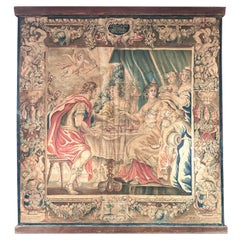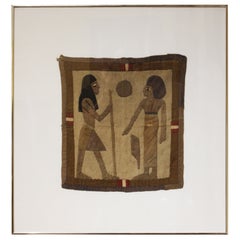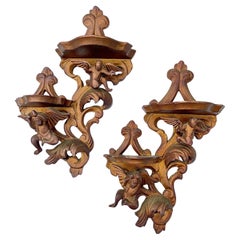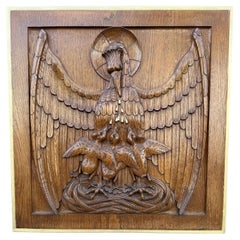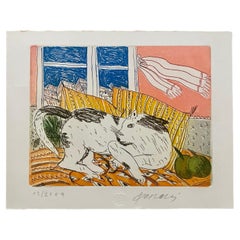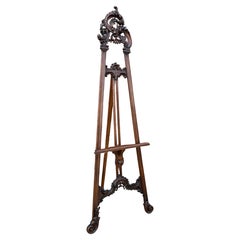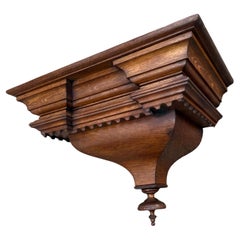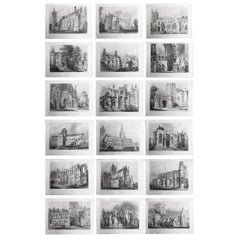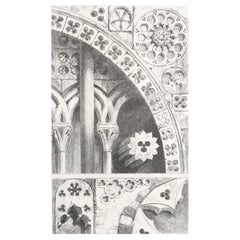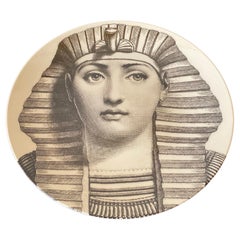Revival Wall Decorations
to
97
178
163
353
9
5
Height
to
Width
to
7,752
6,708
2,129
1,283
889
852
758
571
514
304
290
287
239
202
198
189
154
143
17
193
143
14
59
41
19
10
1
11
5
4
2
3
3
4
7
154
87
79
67
50
302
93
74
38
32
367
365
366
10
5
3
3
3
Style: Revival
Antique Hand-Carved Oak Gothic Panel, Feeding Pelican, Symbol of Christ (1927)
By Known Work
Located in Lisse, NL
This magnificent religious solid oak wall panel in deep relief with a gilded border was crafted in 1927 by the renowned workshop Fa Jos. Thissen & Zn, Roermond, the Netherlands.
...
Category
Early 20th Century European Revival Wall Decorations
Materials
Oak, Paint
Graceful & Hand Carved Antique, Early 1900 Floor Easel / Artist Display Stand
Located in Lisse, NL
Excellent condition, richly detailed, and exceptionally elegant picture stand.
This stunning gallery easel is a pleasure to behold, even without a painting displayed on it. Thanks t...
Category
Early 20th Century Italian Revival Wall Decorations
Materials
Wood
Antique and Quality Hand Carved Solid Oak Neo-Renaissance Wall Bracket or Shelf
Located in Lisse, NL
19th Century Neo-Renaissance oak wall bracket with veneered curved panel.
Wonderful and perfectly hand-carved, this all handcrafted Neo-Renaissance wall bracket has the most strikin...
Category
Late 19th Century European Antique Revival Wall Decorations
Materials
Metal
Set of 18 Gothic Architectural Prints ( Scotland ) After Robert Billings. 1848
Located in St Annes, Lancashire
Glorious set of 18 prints of Gothic Architecture in Scotland
Steel engravings. After R.W. Billings
Published by William Blackwood & Sons, Edinburgh. Dated 1848
Unframed.
Category
1840s Scottish Antique Revival Wall Decorations
Materials
Paper
Original Antique Architectural Print by John Ruskin, circa 1880, 'Lisieux'
By John Ruskin
Located in St Annes, Lancashire
Wonderful Gothic architectural print.
Pierced ornaments from Lisieux, Bayeux, Verona and Padua.
Steel engraving by R.P. Cuff after the original drawing by John Ruskin.
Published, ...
Category
1880s English Antique Revival Wall Decorations
Materials
Paper
Fornasetti Wall Plate Tema E Variazioni N. 221
Located in San Diego, CA
Beautiful wall plate with the interpretation of opera singer Lina Cavalieri’s face are the basis of the iconic Tema e Variazioni series by Fornasetti. Beautiful hand-decorated porce...
Category
20th Century Italian Revival Wall Decorations
Materials
Porcelain
Antique Carved Oak Gothic Art Round Panel of Feeding Pelican as Symbol of Christ
Located in Lisse, NL
All hand carved, quality workmanship and symbolic wall panel in thick relief with high border.
The character ascribed to the pelican in this context is nearly as fabulous as that of...
Category
Late 19th Century European Antique Revival Wall Decorations
Materials
Metal
Pair Rococo Style Carved Hardwood Wall Brackets
Located in Germantown, MD
Pair Rococo Style Carved Hardwood Wall Brackets. Measures 7" in width, 4" in depth and 10" in height.
Category
Mid-20th Century American Revival Wall Decorations
Materials
Hardwood
$896 Sale Price / set
25% Off
Antique Fine Handcarved Oak Gothic Revival Wall Shrine / Chapel for Statuette
Located in Lisse, NL
Rare and good condition, Gothic-art shrine for standing or wall-hanging.
This handsome and decorative, Gothic wall shrine is completely hand-crafted out of solid oak and it will look awesome, no matter where you decide to mount or place her. It must have taken its creator quite a few days to first draw this intricate design on paper and then hand carve the entire piece out of solid oak. The Gothic Style elements are deeply handcarved in both doors and they make this shrine highly decorative and an absolute joy to own and look at. This cabinet chapel (or chapel cabinet) comes with its brass lock in perfect working order and also with its original gothic style key. The handgrip is in fact a Gothic trefoil symbol (for the trinity). What also makes this piece extra attractive is the Gothic church window-like frame behind the doors. It is among the finest we have seen to date and on top of that this antique also has a beautiful and rich patina. By the way, the bronze Mary statuette is not included in our price. Finally, thanks to the hook in the back, mounting this antique chapel...
Category
Early 20th Century French Revival Wall Decorations
Materials
Brass
Pair of Late 19th Century Italian Carved Giltwood Neoclassical Wall Brackets
Located in West Palm Beach, FL
Pair of Late 19th Century Italian Carved Giltwood Neoclassical Wall Brackets, Grand Tour Influences
A finely carved and gilded pair of Italian neoclassical wall brackets, dating to ...
Category
Late 19th Century Italian Antique Revival Wall Decorations
Materials
Gesso, Giltwood
Large Antique Italian School Oil on Canvas Painting Apparition of Mary to James
Located in Lisse, NL
Large size antique Gothic Art painting 'The Apparition of the Virgin Mary to Saint James'.
We are by no means connoisseurs when it comes to antique paintings, but we have seen enough antique paintings to know when something is special, decorative and truly inspiring and interesting to look at. And the large size of this antique work of art, makes it impressive too. Also, because it must have taken one very skilled painter an awful lot of time (probably weeks, if not months) to hand-paint this famous religious scene. According to ancient local tradition, on January 2nd of the year AD 40, the Virgin Mary appeared to James on the bank of the Ebro River at Caesaraugusta, while he was preaching the Gospel in Iberia. Looking at the perfectly painted ancient landscape
and the kneeling figure who is in awe of what he is witnessing (by the river bank) we believe this is in fact the apparition of Mary to James. Following that apparition, by the way, St. James returned to Judea, where he was beheaded by King Herod Agrippa the first (in the year AD 44). Judging from the skillfully painted individuals in the Renaissance Style and the striking and lively colors, we believe, this late 1800s painting is the work of a true artisan. This work of religious art on the back reads 'Sacerdote Salvatore Rosa, Dipinse 1889' which means Priest Salvatore Rosa, Painted 1889. This priest clearly had a god given talent and god bless him for having created this masterpiece.
Apart from some minor imperfections this large and nostalgic painting is in very good condition and we believe it will look particularly great in a church, monastery or chapel. At the same time, a one of a kind antique like this will ofcourse also look great atop the stairwell of a mansion or in the entry hall of a French castle etc. We don't know the 'exact' value of this large size antique painting...
Category
Late 19th Century Italian Antique Revival Wall Decorations
Materials
Canvas, Wood, Paint
Set Four Hand Colored Pierre Gravees Antiques Engravings
Located in Haddonfield, NJ
Fantastic 18th Century Antique Hand-Colored Engravings depicting Greek Mythological scenes. This set of artwork is from J.B. Wicar. These matted and gold gilt...
Category
Late 18th Century European Antique Revival Wall Decorations
Materials
Glass, Wood, Giltwood, Paper
French Faience Plate Model "Callot" Longchamp Circa 1920
By Longchamp
Located in Austin, TX
French Faience Plate Model "Callot" Longchamp Circa 1920.
Inspired by Jacques Callot Jacques Callot (French c.?1592 – 1635) etchings.
He made more than 1,400 etchings that chronicl...
Category
1920s French Vintage Revival Wall Decorations
Materials
Faience
$160 Sale Price
20% Off
Antique Gothic Revival Top Quality Hand Carved & Gilt Wooden Church Wall Bracket
Located in Lisse, NL
Deeply carved, extra large size, Gothic Revival corbel, bracket with a stunning patina.
Finding unique antiques that have just that little bit more than your average is what we alwa...
Category
Early 20th Century European Revival Wall Decorations
Materials
Wood, Pine
Impressive Large Size and Deeply Carved Oak Gothic Church Wall Bracket / Corbel
Located in Lisse, NL
Antique large Gothic Revival wall bracket with carved acanthus leafs
This handcrafted and hand-carved, Gothic Revival wall bracket is one of the largest we ever had the pleasure of offering. Together with the natural flowing and deeply carved, acanthus leafs and the Gothic rosettes around the upper rim it also has the most wonderful organic shape. The sheer size of this church relic, its striking design and its ancient patina makes it an absolute joy to own and look at. This is a great bracket for displaying a large saint statue...
Category
Early 19th Century French Antique Revival Wall Decorations
Materials
Oak
Dutch Arts & Crafts Oak Pipe Wall Hanging Cabinet with Glazed Door, circa 1910
Located in Lisse, NL
Handcrafted and rare Arts & Crafts wall cabinet with working lock and key.
A beautifully handcrafted Arts & Crafts oak wall cabinet, dating from the early 20th century, originally d...
Category
Early 20th Century European Revival Wall Decorations
Materials
Metal, Brass
Antique Belgian Verdure Royal Hunting Tapestry, Flemish Renaissance Revival
Located in Dallas, TX
77518 Antique Belgian Verdure Tapestry, 06'10 x 16'07. Woven with a reverence for nature and nobility, this antique Belgian verdure tapestry evokes the poetic splendor of royal fores...
Category
Early 20th Century Belgian Revival Wall Decorations
Materials
Wool
$4,999 Sale Price
20% Off
Monumental Painting of "Duchese du Maire" in Florentine Giltwood Frame
Located in Swedesboro, NJ
This extraordinary monumental oil painting of the "Duchesse du Maire" is an exceptional example of regal portraiture, framed in a breathtaking hand-carved Florentine giltwood frame o...
Category
1930s French Vintage Revival Wall Decorations
Materials
Canvas, Walnut
Max Luber (Munich 1879-1950) Floral Still Life; Oil on Canvas
Located in San Francisco, CA
the lushly painted still life depicting a woven basket full of finely painted bearded irises, parrot tulips, hydrangeas and peonies with discreetly painted bees and a snail; all rest...
Category
Early 1900s German Antique Revival Wall Decorations
Materials
Canvas
Antique Painting of Holy Mary & Child after Nicolo Barabino in Oak Gothic Frame
Located in Lisse, NL
Symbolic and meaningful work of religious art with original label on the back.
Framed oil on wooden panel, Madonna and child, after Italian Nicolo Barabino (1833-1891). The original...
Category
1890s Italian Antique Revival Wall Decorations
Materials
Oak, Paint, Wood
Fine Gothic Painting / 2nd Station Crucifixion, Jesus Takes Up His Cross
Located in Lisse, NL
Another stunning hand-painted oil on canvas work of religious art.
This antique oil painting was first hand-painted on canvas and later mounted onto a zinc backplate .. a traditiona...
Category
Early 19th Century European Antique Revival Wall Decorations
Materials
Iron, Zinc
Linocut Lithograph “The Cat” by Alekos Fassianos, Art Serigraph, 1990s.
Located in Lille, FR
“The Cat” by Alekos FASSIANOS (1935–2022) – Color Linocut print.
A striking color linocut print by renowned Greek artist Alekos Fassianos, on high-quality Fabriano paper.
Signed and...
Category
1990s French Revival Wall Decorations
Materials
Paper
French Baroque Style Parcel-Gilt Carved Wood Wall Bracket, Sconce, or Shelf
Located in Kinderhook, NY
A large last half of the 19th century French Baroque style stained, painted, and parcel-gilt wall bracket of unusual bisected cornice form having stained chestnut shelf above compoun...
Category
Late 19th Century French Antique Revival Wall Decorations
Materials
Wood, Giltwood
$1,872 Sale Price
52% Off
Antique Large Hand Carved Oak Gothic Art Panel, Depicting Christ and 12 Apostles
Located in Lisse, NL
Stunning and unique 'sermon on the mount' wall plaque with Jesus and the apostles carved in high relief.
This large size work of religious art dep...
Category
Early 19th Century Dutch Antique Revival Wall Decorations
Materials
Oak
Rare Antique Gothic Revival Medieval / Chimera Sculpture Wall Bracket or Shelf
Located in Lisse, NL
Stunning and deeply carved nutwood, Gothic Art wall bracket, Corbel.
If you are a collector of rare and striking Gothic antiques then this bracket could be the perfect addition to your collection. This all handcrafted and marvelously hand carved, 19th century wall bracket is a work or art in its own right. It depicts a medieval figure...
Category
Mid-19th Century French Antique Revival Wall Decorations
Materials
Metal
SECOND HALF OF THE 19th CENTURY LARGE PAINTING WITH ANTHONY AND CLEOPATRA
Located in Firenze, FI
A beautiful, large painting on canvas made with vegetable dyes. The painting depicts the banquet between Antony and Cleopatra; as Plutarch notes, Cleopatra organized a sumptuous banq...
Category
Late 19th Century Italian Antique Revival Wall Decorations
Materials
Canvas, Paint
A.W.N. Pugin Gothic Lily Wallpaper Rolls, Woollam & Co. of London, 1850
Located in Brooklyn, NY
Augustus Welby Northmore Pugin created around one hundred wallpapers, which were manufactured and flocked by William Woollams & Co of London.
Augustus Welby Northmore Pugin created a...
Category
19th Century English Antique Revival Wall Decorations
Materials
Paper
$3,600 Sale Price
25% Off
19th Century French Majolica Palissy Wall Bracket Shelf With Putti Merman
Located in Austin, TX
Large 19th Century French Majolica Palissy wall bracket shelf with Putti Merman.
Thomas Sergent unsigned.
Height / 11.5 inches.
Category
1880s French Antique Revival Wall Decorations
Materials
Ceramic
$1,760 Sale Price
20% Off
Italian School Painting of Madonna and Child
Located in Woodbury, CT
19th century Italian School oil on canvas of Madonna and child. Gilt frame.
Category
19th Century Italian Antique Revival Wall Decorations
Materials
Canvas
Antique Large Oak Panel Depicting Teachings of Jesus, Christ Sermon on the Mount
Located in Lisse, NL
Gothic Revival 'sermon on the mount' wall plaque with Jesus teaching.
This large size work of religious art depicts Jesus and He is surrounded b...
Category
Early 19th Century Dutch Antique Revival Wall Decorations
Materials
Oak
Antique and Quality Hand Carved Solid Oak Gothic Church Wall Bracket or Shelf
Located in Lisse, NL
Great looking and deeply carved Gothic Revival bracket for displaying a Saint statue.
This Gothic console for wall mounting dates from the late 1800s and it has a marvelous combination of floral Gothic elements that make it a joy to own, to use and to look at. All handcrafted more than 100 years ago and always well taken care of, this Gothic Revival wall bracket has the most wonderful shape and a striking patina. This organic design with its natural, flowing lines of the deeply carved Gothic leaves also give it an almost circular look and feel.
This rare church relic was once connected to a church column where it would undoubtedly have been the base for a marvelous Saint statue. If you look closely at the image of the backside, you will be able to see that the rounded part has been professionally flattened out so that it now can be used against a (flat) wall. Apart from a few minor imperfections this Gothic antique of approximately one hundred and fifty years old could not be in better condition. Thanks to the thick wooden opening in the back, mounting this antique bracket...
Category
19th Century European Antique Revival Wall Decorations
Materials
Brass, Metal
Fine 19th Century Oil on Canvas "Triumph of Flora" Attr. Ferdinand Wagner II
Located in Los Angeles, CA
A very fine and large 19th century Louis XV style Whimsical Neoclassical Revival style Oil on Canvas "The Triumph of Flora" attributed to Ferdinand Wagner II (German, 1847-1927), school of François Boucher (French, 1703-1770). The impressive artwork depicting a semi-nude Flora hovering through the clouds surrounded by playful cupids, cherubs, love doves and a seated maiden, within white and grey clouds, offering her Spring flower bouquets and floral wreaths, within a banded giltwood frame. Note: Previously used as a ceiling painting. Unsigned, Circa 1870.
Measures: Canvas height: 91 3/4 inches (233 cm)
Canvas width: 59 inches (150 cm)
Frame height: 61 3/8 inches (155.9 cm)
Frame width: 93 1/2 inches (237.5 cm)
Depth: 2 3/8 inches (6 cm)
Ferdinand Wagner II (German, 1847-1927) was the son of Passau Ferdinand Wagner Senior, a teacher at a vocational art school who began training him professionally at a young age. After traveling to Italy in 1867-1868, he continued with his art studies at The Munich Academy of Arts led by Peter Von Cornelius and Julius Schnorr Von Carolsfeld...
Category
19th Century German Antique Revival Wall Decorations
Materials
Giltwood, Canvas
Richly Carved Baroque Revival Italian Picture Frame with Scrolling Leaves & Vase
Located in Lisse, NL
Stunning antique picture or photograph wall picture frame from the mid 1800's.
This stylish and all handcrafted picture frame will make great decoration on your wall and with a work...
Category
Mid-19th Century Italian Antique Revival Wall Decorations
Materials
Wood
Italianate Baroque Revival Mid Century Yardage
Located in Riverdale, NY
Lovely Baroque Revival Mid Century Yardage from a high end upholsterer who carried a lot of Scalamandre textiles. On its original bolt, it is is marked 32-33 yards on end. Feels like...
Category
1940s American Vintage Revival Wall Decorations
Materials
Cotton
$1,000 Sale Price
20% Off
19th-C. Large French Carved & Cerused Fruit & Floral Pine Wall Brackets - Pair
Located in Kennesaw, GA
I love the scale of these wall brackets! This is a pair of late 19th century French carved pine wall brackets. They are heavily carved with a fruit and floral motif. The pine has a...
Category
Late 20th Century French Revival Wall Decorations
Materials
Pine
Large Oil on Canvas Painting of ‘Venus & Cupid’ After Hans Zatzka
By Hans Zatzka
Located in Dallas, TX
PRESENTING a FANTASTIC and LARGE Oil on Canvas Painting of ‘Venus & Cupid’ After the original masterpiece by renowned artist, Hans Zatzka.
This is a mid to late 20th Century, circa ...
Category
20th Century Austrian Revival Wall Decorations
Materials
Canvas, Giltwood
Red Barn Oil on Canvas Landscape Signed C.G Moody
Located in Pasadena, CA
Oil painting on canvas proudly signed C. G. Moody untraceable painter!
It sits in a very nice and matching frame chosen by the artist.
In this impressionist painting from the 196...
Category
1960s American Vintage Revival Wall Decorations
Materials
Canvas, Paint
Mid-Century French Empire Revival Terracotta Wall Brackets W/ Water Gilt - Pair
Located in Kennesaw, GA
This is a pair of French Empire revival terracotta wall brackets with lovely water gilt finish. They date to the middle of the 20th century. They are unmarked and in very good condit...
Category
Mid-20th Century French Revival Wall Decorations
Materials
Terracotta
Large Antique Oil on Canvas Painting of Saint Joseph W. Lily and the Child Jesus
Located in Lisse, NL
Early religious work of art, presented in the original antique frame.
This beautiful and uplifting portrait of Saint Joseph holding hands with the child Jesus is an oil on canvas an...
Category
18th Century European Antique Revival Wall Decorations
Materials
Linen, Wood, Paint, Plaster
Antique 19th Century German Grunderzeit Wall Cabinet / Small Cabinet Carved Oak
Located in Ijzendijke, NL
Magnificent and very rare Gründerzeit wall cabinet handmade from European oak.
Striking German design from the 1880s made with exquisite craftsmanship.
Solid oak and original oak...
Category
Late 19th Century German Antique Revival Wall Decorations
Materials
Wood, Oak
$1,374 Sale Price
20% Off
Antique Small Wall Cabinet Gothic Revival Hand-Carved Oak Painted Twist Church
Located in Ijzendijke, NL
Antique Wooden Carved Hand Painted Neo-Gothic Small Wall Cabinet France 19th Century Pediment Twisted Medicine Cabinet Gothic Revival
Truly a beautiful rare and stunning antique hanging cabinet.
Late antique 19th-century French gothic style hand carved solid oak one-door small wall cabinet.
With a romantic hand painted door with flowers, and inside a nice layout.
Twisted columns and is topped by gothic-like spires.
And lots of more decorative details!
In good authentic antique condition, with some normal traces of use and wear.
Please see pictures and video, they are part of the description.
This breathtaking antique showpiece...
Category
Late 19th Century French Antique Revival Wall Decorations
Materials
Oak
Gothic Revival Stained Glass Architectural Wall Cabinet 1880 with Bronze Details
Located in Glenford, NY
Very Fine Gothic Revival Cathedral Style Wall Bracket/cabinet with Original Stained Glass and fine Bronze Details - cherub faces, door with detailed latch, column motifs, and scallop...
Category
19th Century American Antique Revival Wall Decorations
Materials
Bronze
Hispano-Portuguese 19th Century Oil Painting on Board, Icon "The Crucifixion"
Located in Los Angeles, CA
An Hispano-Portuguese 19th century oil on board depiction of "The Crucifixion". The baroque icon style painting depicting the Crucifixion of Jesus Christ outside the city walls of Jerusalem, north of Mount Zion...
Category
19th Century Spanish Antique Revival Wall Decorations
Materials
Wood
$9,450 Sale Price
36% Off
19th Century Italian Oil Painting in the Manner of Antonio Panini
Located in Hudson, NY
This fine old painting is a typical pastiche of the kind popular throughout Italy and the world in the 17th, 18th and 19th centuries. The most commonly associated artist who really m...
Category
19th Century Italian Antique Revival Wall Decorations
Materials
Canvas, Wood
Selection of eight restored 19th C Neo-Gothic Stained-Glass Windows
Located in Leuven , BE
The Color Experience: Stained-glass windows
“Color is a power which directly influences the soul” (Wassili Kandinsky, Moskou 1866 – Neuilly-sur-Seine, 1944)
“Color! What a deep and mysterious language, the language of dreams!” (« La couleur ! Quelle langue profonde et mystérieuse, le langage des rêves », Paul Gauguin, Paris, 1848-Fatu-Hiva, 1903)
‘Color and feeling’, ‘color and meaning’, these are concepts that have gone together since time immemorial. Artists and craftsmen have a special bond with color. After all, it is a means of expression that can have a real reinforcing effect. Especially linking color with light offers unlimited possibilities. Glaziers and glass painters have tried to master both these ‘instruments’ for centuries.
The set of beautifully restored neo-Gothic windows in our collection are enough reason for us to let these works of art figure in a broader story. As a bonus, we would like to introduce you to the contemporary stained-glass artist and stained-glass restorer, Daniël Theys. whose workshop is in Sint-Pieters-Rode (Belgium). He talked to us about the materials and techniques he used for the restoration of our set of neo-Gothic stained-glass windows. A fascinating look at the tricks of the trade from a specialist!
A bird’s eye view of the history of the European stained-glass window.
Although the Romans already used translucent glass plates to cover wall openings, the stained-glass window reached its peak in Europe between 1150 and 1500. A period also known as the era of the cathedrals. At that time, stained-glass windows became more than just a way to let in the light, and to keep the space closed off. From now on, their functionality was also found in their didactic value. The biblical and saints’ stories that adorned the stained-glass windows became a kind of poor man’s bible. They brought, as it were, the knowledge of the holy scriptures in an understandable, pictorial way. At the same time, the colored light provided additional symbolism. The invading light was interpreted as a manifestation of God. It is also no coincidence that the main altar was bathed in light. It was the place where the most important sacrament was celebrated, that of the Eucharist. How were these magical colors obtained? Well, during the 12th and 13th centuries, metal oxides gave color to the glass. Copper, for example, produced different colors in the various stages of oxidation. The metal could color the glass light blue, green and even red. It should be noted that from the 13th century onwards, clear glass, which was cheaper and at the same time allowed more light into the buildings, was used more often. A century later, in the years 1400 to 1500, glass painters frequently painted onto the glass with a ‘stain’ of silver chloride or sulfide. The painted piece of glass was heat-treated in a furnace. The heating process ensured that the silver ions migrated into the glass and became suspended within the glass network. The stain gave colors ranging from a pale yellow to a rather deep red. This new technique allowed glaziers to get more than one color on a single glass fragment. The shades produced by painting in silver chloride were well suited for depicting golden crowns, scepters and other gilded objects and ornaments. But the most important advantage of the technique was the fact that the glass painter could now make transitions from yellow tones to white without having to apply separations with lead strips! This also improved the legibility of the pictured scene.
You can imagine that the labor-intensive process of the production of stained-glass windows was a very costly affair and therefore it was often patrons who donated them to a church or a chapel. The benefactors were usually eager to propagate their social status and were moved by concern for their salvation.
In the 16th century, stained-glass windows also began to appear in secular buildings such as town halls, the homes of the wealthy and commercial premises such as inns. It is striking that during this period the use of lead strips that border many parts of the image was further reduced in favor of real painting on stained glass. This was due to an increasing love of detail. For example, one wanted realistically painted portrait heads. Working with enamel paints was cumbersome. Each newly applied color had to be burned into the glass before another color or overpainting could be applied. It was not only the coloring of the glass that was complicated, the process of obtaining flat glass plates required many steps as well. The glazier blew a glass bulb with a blowpipe and then cut it open. Finally, each half of the sphere was turned around so fast that it became a disc. In later periods, the glazier blew out his glass bulb into a cylinder. Once the cylinder had cooled, its closed ends were removed, and the long sides were cut open. The pieces of glass obtained were then heated and flattened. During the 16th century, there was a division of labor between the stained-glass designer, the glazier, and the glass painter. It happened as well that the stained-glass artist used prints as models for his stained-glass windows. Whoever drew the design, the glazier always needed a model on the right scale, the so-called cartoon. On the cartoon, the lead strips were clearly marked, and the use of colors was indicated. Contracts at the time show that the price of stained-glass windows was calculated per square foot. The price per square foot included the labor and material costs. The price of the cartoon was not included.
In the 17th century, the work of glass painters remained important. At the same time, there was a growing popularity of stained-glass windows with heraldic themes. In the Low Countries there were several high-quality glass painters active.
During the 18th century, glass painting went downhill in our regions. The French occupation of the Southern Netherlands resulted in the destruction and sale of religious stained-glass windows.
It was only around the middle of the 19th century that the young Belgian state experienced a revival of stained glass. The renewed interest in the Middle Ages, the so-called ‘gothic revival’, caused a wave of restoration of old stained-glass windows of churches and orders for neo-gothic stained-glass windows. The Sint-Lucas art schools in Belgium played an important role in this. Industrial developments in the glass and steel industries naturally had an important hand in the popularity of stained-glass windows. Stained-glass had a wide range of uses; think of stained glasses in winter gardens, domes, windows, and doors of large mansions. Significant glazier’ studios arose in several larger Belgian cities. In Brussels, for example, you had the workshops of Capronnier and Colpaert, in Bruges the studios of Coucke and Dobbelaere, in Ghent the companies of Ganton-Defoin or Ladon. During the 19th century, glaziers followed the style developments in the visual arts. For example, the number of windows in Art Nouveau and Art Deco style is large. The restored stained-glass windows with male and female saints that we offer for sale, come from a building in Laeken, near Brussels. They probably decorated the space of a church, chapel, convent, or Catholic school. In the results of the interview with glass restorer Daniël Theys, you will learn more about the particularities of these splendid windows.
Chatting and browsing in the workshop of Daniël Theys
The Belgian Glass restorer and glass blower, Daniël Theys (), made a career switch at a later age and has been active in the profession since 1987. He is an important player in the field of stained-glass window art in Belgium. Moreover, he is the only one in the country who still masters the technique of glass etching. Daniël Theys receives many commissions from small parish churches to restore old stained-glass windows to their former glory. He made a name for himself in that niche and that is how Spectandum brought the set of 19th century stained glass windows to his workshop for reconstruction. They were delivered in old numbered wooden crates and Daniel had to start puzzling.
Numbered wooden crates with sections of the stained-glass windows
Normally a glazier starts working from a drawing with a scale of 1:1 (full size drawing), but in this case each piece had to be cataloged and photographed. The smaller pieces were grouped on the light box and photographed in their entirety. Then Daniël made a drawing of the remaining pieces that he had puzzled together with great care.
Smaller pieces identified and grouped on the light box
The restauration guidelines of the Agency for Monuments and Landscapes are not always the same as those of a restorer. For this reconstruction, Daniël primarily considered the purpose of the stained-glass windows. It had to be an aesthetic and salable set of stained-glass windows, so the choice of filling the gaps with neutral glass or epoxy was not really an option. Theys left well-executed previous restorations untouched. The windows may have been repaired three or four times in the past.
Piece of a cloak with glass shards from different periods (restorations)
Another problem Daniel faced during the restoration was the fact that some small parts of the old grisaille had been eaten away by microorganisms. The defect – caused by moisture – can be seen from the discoloration of the grisaille. The black-brown color is turned red.
This fragment shows well how the brown grisaille has turned red due to the attack of micro-organisms
The stained-glass windows of the 19th century are made of ‘in the mass-colored’ glass. This means that the colors were added to the liquid glass during its production process. This type of glass differs from glass colored with enamel paint, which became popular from the interwar period. The latter process involves applying enamel paint (this is a glass powder with a metal oxide to which a medium has been added) to the colorless glass. When firing the glass with the enamel paint, the powder fuses with the glass. The colors of email painted glass are less intense and less brilliant than those of ‘in the mass-colored glass’.
Jars with colored powder for the enamel paints
For the restoration Daniël only worked with mouth-blown glass, both with ‘in the mass-colored glass’ and with ‘verre plaqué’. This is blown glass composed of several layers of different shades. Over the years, Theys built up a large stock of old blown glass. Colored blown glass always has sliding shades. For example, a red piece of glass can have a color transition from bright red to light orange. These differences in shades are the result of the different thicknesses of the piece of glass. It allows the glazier to use a wide variety of shades.
The purple-red foliage with light blue accents was obtained by etching away parts of a piece ‘verre plaqué’. A small part of the lower glass layer is exposed.
The windows were completely re-leaded by the restorer because there was virtually no ‘lead net’ preserved. In general, lead strips only have a limited lifespan because of oxidation processes. Daniël removed the old lead remnants and placed new lead profiles. Then he applied putty between the glass fragments and the lead strips to seal the lead. A window must be made watertight. The current condition of the windows is excellent.
Decorative glass part with original lead remnants
New lead strip
The set of stained-glass windows we present today, originally consisted of windows of 5 to 6 m high. After all, they originally adorned a neo-gothic church. Since the original dimensions are not suitable for private buildings, it was decided to only restore the figurative representation.
The original spire of one of the windows
Thanks to a suspension eye, the window can be hung. There is also the possibility to place the window in an upright position.
Thanks to the craftsmanship of the Theys-Studio, we can once again enjoy the brilliance of color!
Looking for the missing link
The set of 19th-century stained-glass windows came into the possession of Spectandum without a clear provenance. The renowned Leuven antiques dealer, Cornelius Engelen, recalls that the windows came from a church in Laeken. There is no solid starting point for a search for the provenance. Based on the style of the stained-glass windows – most probably the late 19th century -, their religious iconography, and their original shape (pointed arch windows) and dimensions (5 to 6 cm high), we can assume that they were once displayed in a (neo-)gothic cult building. On the one hand, the stained-glass windows may have been removed after storm damage or other calamities, on the other they may have been taken away during a renovation or a demolition of a church. The Church of Our Lady in Laeken is the most famous church building in that municipality that could qualify. In the early 1920s, the central windows of the transept were badly damaged by a hurricane. Today, glass fragments of these windows (dating from 1893-1894) with the names of the sixteen missing saints and an arch infill of the western window are officially known. It would be interesting to find out if our set of eight saints once were part of the transept of Our Lady in Laeken. Research in the records of the church administrators could provide clarification. Knowing that most neo-gothic stained-glass windows from the Church of Our Lady come from the Jules Dobbelaere’s glass studio in Bruges, it is useful to consult that company’s archive as well. It is kept in the KADOC (Documentation and research center for religion, culture and; in Leuven. Of course, the sizes and shape of the stone window openings of the transept can also provide an indication. If we stylistically compare the grisailles of the set of stained-glass windows with the work of Jules Dobbelaere, we do see some relationship. Especially with a stained-glass window in the chapel of Our Lady of the Saint Anthony Church in Aalst.
Another line of research that we could follow, is that of the iconography of the series. One of the saints depicted is Saint Roch. There once was a Saint-Roch church in Laeken with 19th-century stained-glass windows from the Brussels studio of Jean-Baptiste Capronnier. The company archive of the glaziers François and Jean-Baptiste Capronnier is owned by the Flemish government and can be consulted in the above-mentioned KADOC. We already searched the sales catalog of 1892, in which Capronnier’s drawings and cartoons are described one by one. The saints that are represented in our set of windows, does not correspond with the names of the saints mentioned for the church of St. Roch in Laeken. Building on this argument, it can be concluded that the eight saints were not destined for this house of worship.
In the absence of lavishly illustrated monographs on the various glazier-companies in Belgium, the execution of a comparative study of the stained-glass windows is time-consuming and complex. Although a limited number of old photos of stained-glass windows can still be found in the database ‘Balat’ of the KIK-IRPA (), this remains far too limited to get a good picture of the output of the various companies.
19th C, Saint, Neo-Gothic Stained-Glass Window with Saint Martin, Belgium, 163 x 73 cm
Most people know Saint Martin (Szombathely, ca. 316 – Candes, 397) as the Roman Tribune who cut his cloak in two with his sword and gave one half to a beggar. The artist of the stained-glass window has opted for a different, less common iconographic representation here. Saint Martin is presented as a bishop with a miter and staff. According to a legend, Martin was lured to the city of Tours with a trick to consecrate him as a bishop. He refused the ecclesiastical office and hid in a barn with some geese. The birds betrayed him with their twittering. In the end Martin received his episcopal consecration. The goose at the feet of the saint clearly refers to this event.
19th C, Saint, Neo-Gothic Stained-Glass Window with St. Angela, Belgium, 163 x 73 cm
Angela de Merici was an Italian woman who taught young women religion, health care, and household skills. She founded the monastic community of the Ursulines. They played an important social role as founders of schools and orphanages. Saint Angela died in Brescia in 1540. It should therefore come as no surprise that the saint on the stained-glass-window is depicted with
a girl by her side.
19th C, Saint, Neo-Gothic Stained-Glass Window with Charles Borromeo, Belgium, 163 x 73 cm
Charles Borromeo (Milan, 1538-1584) grew up in a noble family. He was already made Cardinal and Archbishop of Milan at the age of 24. With his writings he contributed to the implementation of the Church reforms determined at the Council of Trent. Among other things, he released a new catechism. With his book on the design of church buildings, “Instructiones Fabriacae et Supellectilis Ecclesiasticae”, he left a mark on Baroque church construction. At the outbreak of the plague in his diocese in 1576, he devoted himself to the care of those affected. Hence, people sometimes pray to him when they have been hit by a serious illness.
19th C, Saint, Neo-Gothic Stained-Glass Window with St. Roch, Belgium, 163 x 73 cm
Saint Roch (Montpellier, 1295? /1350? -1327? /1380?) was born with a port-wine stain in the shape of a cross on his left hip. It was interpreted as a sign from God. After the dead of his parents, he gave his money to the poor and went on to live the life of pilgrim. He cared for plague sufferers and healed some of them by making a sign of the cross. He is especially invoked as protector against the plague.
19th C, Neo-Gothic Stained-Glass Window with St. Bernard of Clairvaux, Belgium, 163 x 73 cm
Bernard of Clairvaux (Fontaines, 1090-Clairvaux, 1153) decided to become a monk at the age of 21. In 1112 he entered in the monastery of Cîtaux. He was soon commissioned by the abbot to find a new monastery in Clairvaux. Because of his intellectual capacities and eloquence, he was consulted by various ecclesiastical and secular leaders. He ensured the expansion of the Cistercian order throughout Europe. As a Doctor of the Church, he wrote many tracts and sermons and established a new rule for the Templars. Above all, he was concerned with the discipline of the clergy. Therefore, he wrote a spiritual manual for the priests and bishops. Saint Bernard can be seen as a true mystic. He envisioned the union of the human soul with God as the most important goal in life. According to a legend, Bernard once had a vision in which the Blessed Virgin appeared to him and strengthened him with her mother’s milk. In the arts, the saint is mainly depicted with an abbot’s staff and a book with the Cistercian rule. His vision was also often portrayed.
19th C, Neo-Gothic Stained-Glass Window with St. John Berchmans, Belgium, 163 x 73 cm
The Belgian Jan Berchmans (Diest, 1599-Rome, 1621) was the eldest of five children. When his mother became seriously ill, he initially took care of her, but at the age of nine he was housed with the town’s priest. After a few years he moved to Mechelen to become the servant of a canon. It also gave him the opportunity to begin his studies in the seminary for priests. He eventually joined the Jesuits of Mechelen. He got their permission to study philosophy in Rome. In the Eternal City, he visited working-class neighbourhoods to teach the children about God. He died of an illness at the age of 22. Saint Jan Berchmans is the patron saint of school children and students.
19th C, Neo-Gothic Stained-Glass Window with Saint Clare...
Category
19th Century Belgian Antique Revival Wall Decorations
Materials
Art Glass, Stained Glass
Antique Mamluk Revival Egyptian Khedival Khayamiya Cotton Appliquè Hanging
Located in Milan, IT
Derived from the Arabic 'khayam' (tent), the Egyptian khedival khayamiya are elaborately hand-stitched appliquè cotton hangings, woven in the golden period between 1867 and 1914. Wha...
Category
Late 19th Century Egyptian Antique Revival Wall Decorations
Materials
Cotton, Linen
19th Century Italian Religious Icon Oil Painting in Gothic Revival Cabinet Frame
Located in London, GB
Antique Religious Oil Painting, Antique Religious Icon, Antique Gothic Revival Religious Painting, Antique Gothic Revival Cabinet, Reli...
Category
1890s Italian Antique Revival Wall Decorations
Materials
Copper
Large Vintage Molded Semi-Nude Neoclassical Styled Female Relief Wall Sculpture
Located in Hamilton, Ontario
This mid-century era molded fiberglass wall sculpture is unsigned, but presumed to have been made in Canada in approximately 1960 in a Neoclassical Revival style. The relief depicts ...
Category
Mid-20th Century Canadian Revival Wall Decorations
Materials
Fiberglass
Antique Russian Orthodox Icon St. Helena & Constantine Marcarius True Cross 1820
Located in Portland, OR
A fine & large antique Russian Orthodox icon, circa 1820.
This large antique Russian icon painted with egg tempera on wooden panel, depicts the "True Cross" to the center with Saint...
Category
1820s Russian Antique Revival Wall Decorations
Materials
Wood, Paint
French Neo-Renaissance Majolica Plate circa 1890
Located in Austin, TX
French Neo-Renaissance Majolica Plate circa 1890.
Decorated with a cavalier on the center, border with medallion portraits.
Category
1890s French Antique Revival Wall Decorations
Materials
Ceramic, Faience, Majolica
$224 Sale Price
20% Off
19th Century Italian Painting of The Virgin of the Fish
Located in Scottsdale, AZ
19th Century Italian Painting of The Virgin of the Fish done in the Purisimo Style. Revivalist piece of a Raphael Painting. The Virgin Mary & baby Jesus with Saint Jerome and Arc Angel...
Category
19th Century French Antique Revival Wall Decorations
Materials
Giltwood, Paint
$636 Sale Price
20% Off
Antique Victorian Cobalt Majolica Plate of Greek Goddesses Barbotine Revival
Located in Bad Säckingen, DE
This large and exquisitely detailed Victorian majolica wall-hanging relief plate features a striking depiction of two elegantly adorned Greek goddesses. Created in a vibrant Barbotin...
Category
1880s German Antique Revival Wall Decorations
Materials
Ceramic
Oil on Canvas "the Prohibited Reading" After Karel Ooms
Located in Los Angeles, CA
A Large Continental Oil on Canvas "The Prohibited Reading " after Karel Ooms (Belgium, 1845-1900). This beautiful executed painting depicts a historical scene of an old man and a young woman who are huddled over a bible. The pair is gazing in apparent concern or alarm, over the old man's shoulder, towards something outside of the picture. The scene is likely set in the 16th or 17th century when Protestants were prosecuted, amongst others, for reading the bible in the vernacular, a practice prohibited by the Catholic Church at the time. Signed (l/r) A. Ribas 15-12-913. Within a giltwood carved frame. circa: Probably Belgium, 1913.
Karel Ooms was born in Dessel on January 27, 1845 as the youngest son of a large peasant family. At school his extraordinary talent for drawing was discovered. When he was twelve his hometown provided financial support which allowed him to study at the Antwerp Academy of fine Arts.
One of his teachers at the Academy was Nicaise de Keyser, one of the key figures in the Belgian Romantic-historical school of painting and a painter of mainly history paintings and portraits. After graduating from the Academy 1865 Karel Ooms was welcomed with pomp in his home town Dessel. He painted two altarpieces for the local church Saint Nicolas, to express his gratitude to his city.
Karel Ooms settled as an independent artist in Antwerp around 1871. He quickly established a reputation as a portrait painter. In addition, he received commissions for religious paintings and history paintings. He gained particular recognition with two large paintings...
Category
Early 20th Century Belgian Revival Wall Decorations
Materials
Canvas, Giltwood
$27,880 Sale Price
20% Off
Relief, “Ballerinas”. Modeled alabaster. 20th century, after CANOVA
Located in Madrid, ES
Relief, “Ballerinas”. Modeled alabaster. 20th century, following the CANOVA model, Antonio
Relief made of modeled alabaster with polychrome, enhanced with a somewhat modern frame th...
Category
20th Century Spanish Revival Wall Decorations
Materials
Other
Exquisite Renaissance Revival Giltwood Griffin Bracket Shelf
Located in Lincoln, GB
Exquisite Renaissance Revival Giltwood Griffin Bracket Shelf
This magnificent large shelf originates from the British Renaissance Revival period and is exquisitely finished in gesso...
Category
19th Century Antique Revival Wall Decorations
Materials
Giltwood
Spanish Hand-Carved Walnut Wood Decorative Wall Panel with Foliage Motifs
Located in Barcelona, ES
Wall Panel / Headboard in Walnut, Spain, 1940s
This architectural wall panel features beautifully handcarved foliage details thorough.
To be used as wall decoration or headboard.
Te...
Category
20th Century Spanish Revival Wall Decorations
Materials
Walnut
$2,394 Sale Price
20% Off
Saverio Manetti Anatra Selvatica Italian Etching Acquarellata a Mano ca 1770
Located in Milano, MI
Saverio Manetti Salvatica Duck Or Cicalona Circa 1770 Saverio Manetti's table describing the Salvatica Duck, also known in Tuscany as Cicalona or Canapiglia Male, is an important ill...
Category
Mid-18th Century Italian Antique Revival Wall Decorations
Materials
Paper, Wood
Triangle Floating Shelves
Located in Oxford, GB
This handcrafted triangle floating shelf is made of natural materials, specifically pencil reed rattan. Its quality construction adds a touch of elegance to any space. Organization m...
Category
2010s Philippine Revival Wall Decorations
Materials
Rattan
$501 / set
Hand Painted Early 20th Century Faenza Ceramic Shelf
Located in Milano, MI
Hand-painted Faenza ceramic wall shelf, made in the early 20th century
Ø cm 19 Ø cm 14 h cm 21
Antique ceramic shelves are fascinating objects that combine functionality with the ...
Category
1920s Italian Vintage Revival Wall Decorations
Materials
Ceramic
Pair of Engravings With Hand-colored Ducks by Saverio Manetti 18th Century
Located in Milano, MI
Set of 2 hand-colored avian engravings, Italian, c. 1770, with figures of wild ducks, the mallard and the cicada, taken from Xavier Manetti's Natural History of Birds. They are on v...
Category
Mid-18th Century Italian Antique Revival Wall Decorations
Materials
Wood, Paper
Revival wall decorations for sale on 1stDibs.
Find a broad range of unique Revival wall decorations for sale on 1stDibs. Many of these items were first offered in the 21st Century and Contemporary, but contemporary artisans have continued to produce works inspired by this style. If you’re looking to add vintage wall decorations created in this style to your space, the works available on 1stDibs include wall decorations and other home furnishings, frequently crafted with wood, glass and other materials. If you’re shopping for used Revival wall decorations made in a specific country, there are Europe, France, and Italy pieces for sale on 1stDibs. While there are many designers and brands associated with original wall decorations, popular names associated with this style include and Robert Pansart. It’s true that these talented designers have at times inspired knockoffs, but our experienced specialists have partnered with only top vetted sellers to offer authentic pieces that come with a buyer protection guarantee. Prices for wall decorations differ depending upon multiple factors, including designer, materials, construction methods, condition and provenance. On 1stDibs, the price for these items starts at $1,396 and tops out at $9,500 while the average work can sell for $2,175.
Recently Viewed
View AllMore Ways To Browse
Portraits Of Queen Victoria
Ruth Porcelain
Tahitian Furniture
Used Furniture Wa
Antique Azaleas
Antique Religious Banner
Berkeley Vintage Furniture
Cow Mount
Dutch Sailing Ship
English Mastiff
Gothic Wood Panels
Religious Banner
Resurrection Of Christ
Ships Plaque
Spanish Conquistador
Vintage 19th Century Dresses
Vintage Brugge
Wall Shrine
